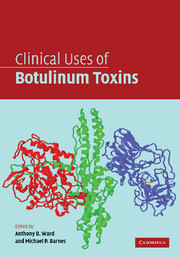Book contents
- Frontmatter
- Contents
- List of Contributors
- 1 Introduction
- 2 Mechanistic basis for the therapeutic effectiveness of botulinum toxin A on over-active cholinergic nerves
- 3 Botulinum toxin: from menace to medicine
- 4 Botulinum toxin: primary and secondary resistance
- 5 Introduction to botulinum toxin in clinical practice
- 6 Cervical dystonia
- 7 The use of botulinum toxin in otolaryngology
- 8 Spasticity
- 9 Hyperhidrosis
- 10 Hypersalivation
- 11 Botulinum toxin type A for the prophylactic treatment of primary headache disorders
- 12 Botulinum toxin in the management of back and neck pain
- 13 Clinical uses of botulinum toxin
- 14 Bladder and bowel indications
- 15 Cosmetic uses of botulinum toxin A
- 16 Other clinical neurological uses of botulinum toxin
- Index
- Plate section
- References
7 - The use of botulinum toxin in otolaryngology
Published online by Cambridge University Press: 02 December 2009
- Frontmatter
- Contents
- List of Contributors
- 1 Introduction
- 2 Mechanistic basis for the therapeutic effectiveness of botulinum toxin A on over-active cholinergic nerves
- 3 Botulinum toxin: from menace to medicine
- 4 Botulinum toxin: primary and secondary resistance
- 5 Introduction to botulinum toxin in clinical practice
- 6 Cervical dystonia
- 7 The use of botulinum toxin in otolaryngology
- 8 Spasticity
- 9 Hyperhidrosis
- 10 Hypersalivation
- 11 Botulinum toxin type A for the prophylactic treatment of primary headache disorders
- 12 Botulinum toxin in the management of back and neck pain
- 13 Clinical uses of botulinum toxin
- 14 Bladder and bowel indications
- 15 Cosmetic uses of botulinum toxin A
- 16 Other clinical neurological uses of botulinum toxin
- Index
- Plate section
- References
Summary
Introduction
In this chapter, the therapeutic use of botulinum toxin for disorders that predominately manifest themselves in the larynx and pharynx will be covered. The treatment of laryngeal dystonia with botulinum toxin remains the best documented use of botulinum toxin in this field but it has been successfully used to treat other laryngeal and pharyngeal disorders (Table 7.1).
Laryngeal dystonia/spasmodic dysphonia
The term dystonia is defined as a sustained, involuntary contraction of muscle that produces an abnormal posture and frequently causes twisting and turning. It is a chronic neurological disorder of the central nervous system characterized by action induced muscle spasms and can be generalized or focal. Dystonia that affects the larynx is usually focal and mainly results in speech disorders but can also, albeit rarely, cause breathing difficulties.
Laryngeal dystonia begins in middle age and is more common in females than males. Adductor dysphonia, which causes strangled voice quality, is much more common than abductor dysphonia, which results in breathy voice. Voice is obviously extremely important in social interactions and in spasmodic dysphonia, voice impairment can be long lasting, which has significant negative social consequences. Patients with spasmodic dysphonia have a high incidence of anxiety and depression and can suffer significant psychological problems. The condition can have a direct effect on their quality of life and work place performance.
- Type
- Chapter
- Information
- Clinical Uses of Botulinum Toxins , pp. 111 - 121Publisher: Cambridge University PressPrint publication year: 2007
References
- 1
- Cited by

